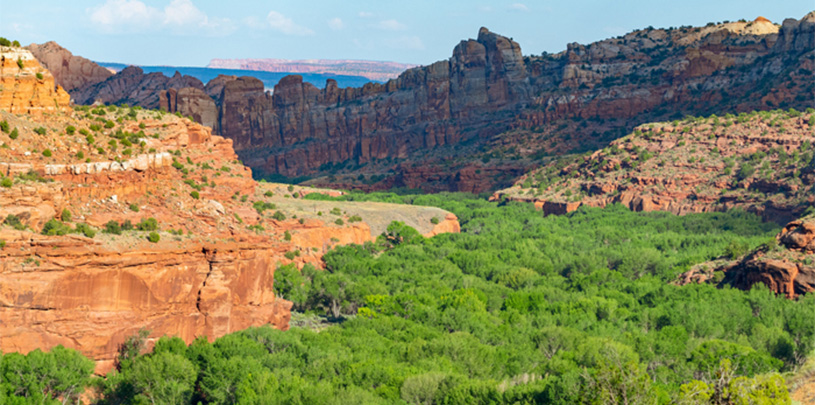
 by Mike Popejoy, Utah Public Lands Director
by Mike Popejoy, Utah Public Lands Director
Grand Staircase-Escalante National Monument’s broad geologic steps, narrow creeks, and stunning canyons call for careful and thoughtful management. You have the opportunity now to share your thoughts about how Grand Staircase-Escalante and its fossils, cultural resources, waters, and living creatures should be taken care of into the future.
The Bureau of Land Management, the agency that manages the monument, is currently accepting public comments on its draft management plan. It solicited comments from the public in 2022 to help develop this draft. Now, the agency is seeking more input to inform its final management plan for the monument, which is expected to be completed next year.
The comment period closes November 9, 2023.
What issues in Grand Staircase-Escalante are most important to you? Let the Bureau of Land Management know. If you’ve spent time on the ground in the monument and have seen damage to cultural sites, springs, or streamside habitats in canyon bottoms (from cattle grazing, recreation, vandalism, etc.), please share that in your comments. Your observations can be very powerful and may provide new insights for the agency.
Below are things the Grand Canyon Trust would like to see included in the final management plan. Help us reinforce these proposals, and feel free to add your own based on your experiences and knowledge.
TIP: The most effective comments are specific and provide reasons for why the Bureau of Land Management should adopt your proposals. Learn how to write meaningful comments ›
 BLAKE MCCORD
BLAKE MCCORD
Tell the Bureau of Land Management you’d like to see old-growth trees (over 150 years old) protected. Old-growth trees provide wildlife habitat and store carbon from the atmosphere. Previous pinyon and juniper tree removal in the monument has eliminated centuries-old trees.
 MARIE READ
MARIE READ
Mexican spotted owls, southwestern willow flycatchers, and pinyon jays face significant challenges as a result of human activities. Tell the Bureau of Land Management to properly protect these birds and their habitats by modifying cattle grazing, pinyon and juniper removal, and recreation as necessary.
 BLAKE MCCORD
BLAKE MCCORD
Thank the Bureau of Land Management for its thoughtful approach to handling voluntary relinquishments of grazing permits. This win-win approach means that willing grazing permit holders can receive payment in exchange for removing cattle from fragile desert landscapes.
 BLAKE MCCORD
BLAKE MCCORD
The Bureau of Land Management must protect streams and plant communities in canyon bottoms from the impacts of cattle. Concentration of cattle in narrow canyons often results in significant damage to these important habitats.
The agency is contemplating closing these areas, including where the Grand Canyon Trust previously facilitated grazing retirement. Tell the Bureau of Land Management to keep former grazing closures in place and to adopt additional closures to prevent ongoing damage to canyon bottoms from cattle. If you have observed such damage firsthand, share that along with reasons why closing these areas to grazing would benefit the land.
 TIM PETERSON
TIM PETERSON
Thank the Bureau of Land Management for its inclusion of a tribal stewardship plan, and encourage the agency to incorporate Indigenous knowledge into every resource area of the monument management planning process, not just archaeological resources.
The agency should expand what it considers a cultural site to include important landscape components as defined by tribal nations, such as culturally significant plants, waters, and gathering places.
Encourage the Bureau of Land Management to adopt protections for cultural sites that place the highest priority on their preservation. The impacts of cattle grazing on cultural sites, including springs, are particularly concerning.
 BLAKE MCCORD
BLAKE MCCORD
Thank the Bureau of Land Management for adopting a zoned approach to recreation management that will reduce user conflicts and increase protection of the monument’s irreplaceable features. Ask the agency to prohibit recreational target shooting and cross-country off-road vehicle use in the monument, as these uses are not compatible with national monument status.
This is your chance to make your voice heard before the final plan is released next year. Please submit your comments by November 9, 2023. You can find more information about the draft plan on the Bureau of Land Management’s website.
With your help, we can set the monument on a course that will preserve the magnificent values of this landscape long into the future. Thank you for speaking up for the land.
Take action. Submit your comment to help shape Grand Staircase-Escalante National Monument’s future.
80% of Arizona voters support Baaj Nwaavjo I'tah Kukveni National Monument, according to a new poll.
Read MoreUtah voters strongly support national monuments in general, and Bears Ears and Grand Staircase-Escalante in particular, a new poll shows.
Read MoreA small victory in the legal case challenging Daneros uranium mine, near Bears Ears National Monument.
Read More